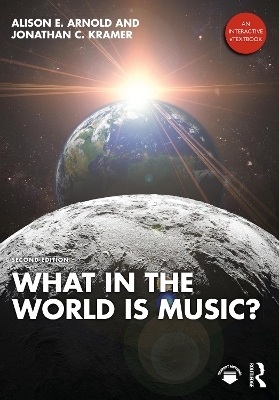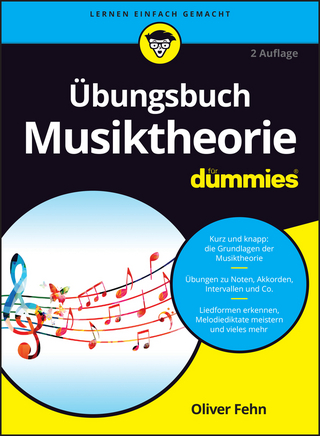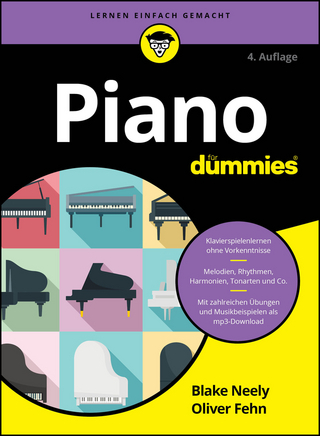
What in the World is Music?
Routledge (Verlag)
978-1-032-34149-1 (ISBN)
What in the World is Music? Second Edition is an undergraduate, interactive e-textbook that explores the shared ways people engage with music and how humans organize and experience sound. It adopts a global approach, featuring more than 300 streaming videos and 50 streaming audio tracks of music from around the world. Drawing from both musicological and ethnomusicological modes of inquiry, the authors explain the nature and meaning of music as a universal human practice, making no distinction between Western and non-Western repertoires while providing students with strong points of connection to the ways it affects their own lives.
The What in the World is Music? curriculum is divided into five parts, with a fully integrated multimedia program linked directly to the chapters:
The Foundations of Music I proposes a working definition of "music" and considers inquiry-guided approaches to its study: Why do humans have innate musical perception? How does this ability manifest itself in the human voice? A catalog of musical instruments showcases global diversity and human ingenuity.
The Foundations of Music II continues the inquiry-guided approach, recognizing the principles by which musical sound is organized while discussing elements such as rhythm, melody, harmony, texture, form, genre, and style. Where did music come from? What is it for?
Music and Identity examines how music operates in shaping, negotiating, and expressing human identity and is organized around three broad conceptual frames: the group, hybridity, and conflict.
Music and the Sacred addresses how music is used in religious practices throughout the world: chanting sacred texts and singing devotional verses, inspiring religious experience such as ecstasy and trance, and marking and shaping ritual space and time.
Music and Social Life analyzes the uses of music in storytelling, theater, and film. It delves into the contributions of sound technologies, while looking at the many ways music enhances nightlife, public ceremonies, and festivals.
Alison E. Arnold, Ph.D., is Lecturer in the Music Department and Assistant Teaching Professor in the Arts Studies program at North Carolina State University. She edited the South Asia Volume of the Garland Encyclopedia of World Music. She performs Celtic Music on Irish flute and whistles, and is Director of the Irish Music Session at North Carolina State University. Jonathan C. Kramer, Ph.D., was Teaching Professor of Music and Arts Studies, North Carolina State University and Adjunct Professor of Ethnomusicology, Duke University until retirement. He is a two-time Fulbright Fellow (India and South Korea) and former cellist with the San Francisco Opera and Ballet Orchestras and the North Carolina Symphony.
Part 1: The Foundations of Music I / Chapter 1: What Is Music? / Chapter 2: What Is Music Made Of? The Human Voice / Chapter 3: What Is Music Made Of? Musical Instruments / Part 2: The Foundations of Music II / Chapter 4: What Is Music Made Of? The Elements of Music / Chapter 5: Where Does Music Come From? The Origins of Music / Chapter 6: What Is Music For? The Functions of Music / Part 3: Music and Identity / Chapter 7: Music and Group Identity / Chapter 8: Music and Hybrid Identity / Chapter 9: Music and Oppositional Identity / Part 4: Music and the Sacred / Chapter 10: Sacred Chant and Devotional Singing / Chapter 11: Sacred Embodiment and Sacred Enactment / Chapter 12: Sacred Space and Sacred Time / Part 5: Music and Social Life / Chapter 13: Narrative Singing, Theater, and Opera / Chapter 14: Music in Public Spaces / Chapter 15: Music and Tourism, Sound Recording, and Film / Glossary / Further Resources / Credits / Media Index / Index
| Erscheinungsdatum | 03.05.2023 |
|---|---|
| Zusatzinfo | 27 Line drawings, black and white; 228 Halftones, black and white; 255 Illustrations, color |
| Verlagsort | London |
| Sprache | englisch |
| Maße | 178 x 254 mm |
| Gewicht | 1160 g |
| Themenwelt | Kunst / Musik / Theater ► Musik |
| ISBN-10 | 1-032-34149-1 / 1032341491 |
| ISBN-13 | 978-1-032-34149-1 / 9781032341491 |
| Zustand | Neuware |
| Informationen gemäß Produktsicherheitsverordnung (GPSR) | |
| Haben Sie eine Frage zum Produkt? |
aus dem Bereich


